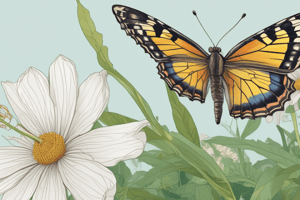Podcast
Questions and Answers
ما هي العملية التي تنقل حبوب اللقاح من المتك الذكري إلى الميسم الأنثوي؟
ما هي العملية التي تنقل حبوب اللقاح من المتك الذكري إلى الميسم الأنثوي؟
- التكاثر الخضري
- التلقيح (correct)
- تكوين الأجنة
- الإخصاب
ما هي الهيكل النباتية المستخدمة في التكاثر الخضري (اللاجنسي)؟
ما هي الهيكل النباتية المستخدمة في التكاثر الخضري (اللاجنسي)؟
- البذور
- الجذامير والريزومات والدرنات والبصيلات (correct)
- الأزهار
- الأوراق
ما هي الهيكل النباتية التي تتحول إلى بذرة بعد عملية الإخصاب؟
ما هي الهيكل النباتية التي تتحول إلى بذرة بعد عملية الإخصاب؟
- الأنثريات
- البويضات
- الأزهار
- البويضات الناضجة (correct)
ما هي الهيكل النباتية التي تتحول إلى ثمرة بعد عملية الإخصاب؟
ما هي الهيكل النباتية التي تتحول إلى ثمرة بعد عملية الإخصاب؟
كيف تصنف النباتات حسب دورة حياتها؟
كيف تصنف النباتات حسب دورة حياتها؟
Study Notes
Flowering Plants: Unveiling the Secrets of Their Life Cycles and Significance
Flowers are delightful, vibrant symbols of nature that bring joy to millions of people worldwide. But did you know that behind their beauty lies a fascinating biological process that ensures the survival and spread of these magnificent organisms? Let's delve into the intricate life cycle of flowering plants, exploring how they grow, reproduce, and contribute to our daily lives, from your dinner table to the clothes you wear.
The Basic Stages of a Flowering Plant's Life Cycle
A flowering plant's life cycle begins with a seed, which, when exposed to suitable conditions, splits open, allowing the embryo within to start growing. The first signs of growth are the development of roots, which anchor the plant deep into the soil, and the emergence of a shoot, which eventually becomes the stem that transports water and nutrients throughout the plant. Meanwhile, the stem's primary function shifts from growing upward to supporting leaves, which absorb sunlight in order to carry out photosynthesis and produce energy for the plant's growth.
As the plant reaches maturity, it prepares to reproduce by producing flowers. These specialized structures serve a dual purpose: they are integral to sexual reproduction processes, including pollination and fertilization, and they attract potential pollinators via their vivid colors and enticing fragrances.
Pollination and Fertilization
Pollination refers to the process by which pollen, typically produced in the male anthers of the flower, is transported to the female stigma. Once there, the pollen grain comes into contact with the receptive surface of the stigma, initiating a series of events leading to fertilization. During this phase, the pollen tubes grow towards the ovules, carrying sperm cells that ultimately merge with the waiting egg cells, resulting in a zygote formation.
After successful fertilization, the zygote divides repeatedly, forming a multicellular organism known as an embryo. Simultaneously, the ovule transforms into a seed, encasing the embryo and providing essential resources for the future plant's growth. Furthermore, the ovary surrounding the ovules expands and ripens into fruit, enclosing the seeds and protecting them until conditions become favorable for germination.
Vegetative Reproduction: A Backup Plan for Continuity
While flowering plants primarily rely on sexual reproduction to propagate, certain species employ vegetative reproduction as an alternative method to produce new individuals from existing ones. This asexual reproduction involves various structures such as stolons, rhizomes, tubers, and bulbs that give rise to new plants, ensuring continuity in plant populations even under less-than-ideal conditions.
Length and Variability of Life Cycles
Flowering plant life cycles exhibit significant variation between species, ranging from plants completing their life cycle within weeks to others taking years or even decades. Annuals are those that bloom, reproduce, set seeds, and die all within one year, while biennials follow a two-year pattern of growth, flowering, and death, followed by new plant regeneration. Perennials, on the other hand, can live for three or more years, some bearing flowers every year while others keep their vegetative parts intact through winter, with springtime sprouting new stems destined to bear flowers in due course.
Significance of Flowering Plants in Our Daily Lives
Flowering plants have become an indispensable part of our lives, providing us with food, clothing, medicinal substances, materials like wood and paper, and numerous decorative and landscaping options. Many fruits and vegetables we consume daily originate from different phases of various flowering plant species. For instance, tomatoes, pumpkins, and cucumbers are technically fruits since they contain seeds.
Moreover, these plants play significant roles in literature and art, inspiring countless poems, paintings, and literary works throughout the ages. They also contribute to cultural practices such as ikebana, flower arranging, and bonsai, showcasing their versatile significance across diverse spheres of human activity.
Studying That Suits You
Use AI to generate personalized quizzes and flashcards to suit your learning preferences.
Description
استكشف دورة حياة النباتات المزهرة وكيف تكمن خلف جمالها عملية حيوية مذهلة تضمن نجاحها وانتشارها. انغمس في الدراسة المفصلة لكيفية نموها وتكاثرها ودورها الحيوي في حياتنا اليومية، من طاولة العشاء إلى الملابس التي نرتديها.




